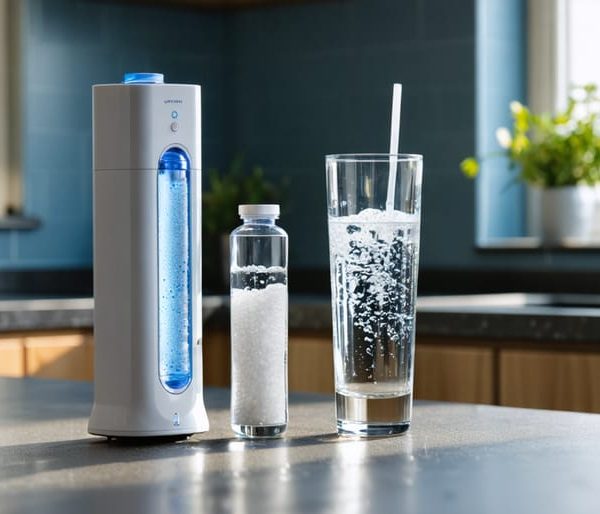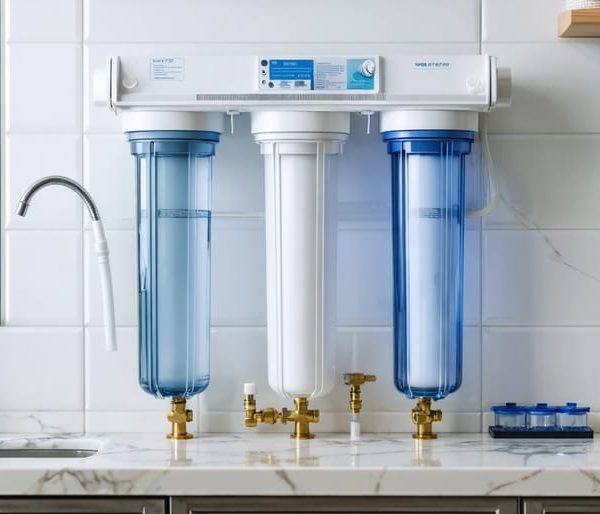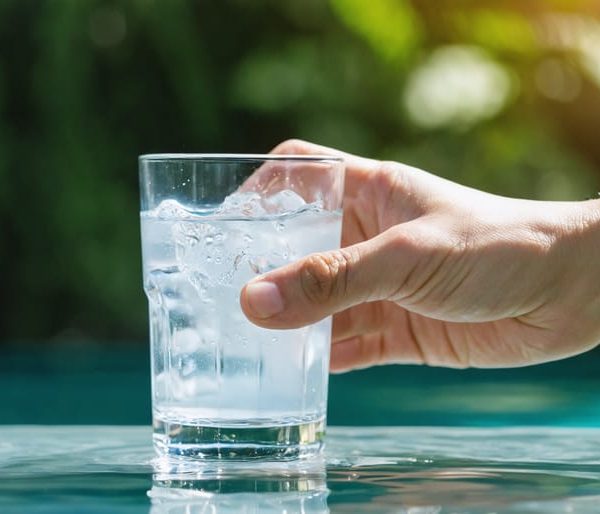While the RO purifier is best for the removal of TDS in water, the UV purifier is best for the removal of microorganisms in your drinking water. Many households end up with the wrong water purifier because they are not aware of the distinction between RO vs UV water purifiers and how they can serve their home.
Reverse Osmosis Filters
RO systems use water pressure to force water through a semi-permeable membrane. When your water flows through this reverse osmosis membrane, it removes toxic substances and harmful contaminants. Reverse osmosis systems are highly recommended for TDS-rich water supply.
It also gives your water a better taste because it treats hard water and gives you soft water. Though, removing total dissolved salts, the RO purifier also removes essential minerals.
A downside to using the reverse osmosis system is that they’re not effective in sterilizing microbes. However, advancements in technology are compensating for that because modern RO water purifiers are equipped with UF and UV technologies.
UV Water Purifiers
UV purifiers utilize a UV light source to emit UV rays. Before we go further, it’s essential to know three types of ultraviolet rays. There are UVA rays (for sun tanning), UVB (sunburning), and UVC (for killing germs). The third ray is the most severe and intense, and it’s powerful enough to kill bacteria and other disease-causing pathogens.
The UV filter works by letting the water pass through a chamber or housing that contains the UV lamp. The emissions from this lamp sterilize these microorganisms.
Even if there’s an invisible bacteria in your water, it will become harmless in your water once it’s exposed to the UV rays. But, just like the RO purifier, there’s also a downside to UV systems. It cannot effectively tackle TDS in your drinking water.
RO vs UV Water Purifier Comparison
We’ll be comparing both water purification systems in certain sections to have considerable knowledge of the drinking water filter you want to buy for your home.
Range of Water Treatment
In certain countries, their wells are mainly contaminated by waste products. Such water also contains high TDS levels (above 300 ppm), making the water unwholesome for consumption.
In this instance, RO filters are ideal because they are effective in TDS filtration, as we mentioned earlier. This makes the water more usable in the home.
On the other hand, TDS is beyond the filtration range of UV treatment. Hence, they are not recommended for well water. Ultraviolet purifiers are better suitable for purifying water already low in TDS (below 300 ppm)—for instance, city water, lakes, and rivers.
The UV water purifier concentrates on the removal of microorganisms.
When it comes to muddy water, both RO and UV water purifiers will need to be coupled with a sediment filter. This pre-filter will trap the silt, rust, and sediment, allowing clear water to flow through.
If your water is rich in both microbes and dissolved solids, an RO-UV combination is ideal.
Affordability
When it comes to how much they cost on the market, most UV purifiers are budget-friendly. So if you’re on a tight budget and want to rid your water of harmful microorganisms, your go-to water system should be UV water purifiers.
On the other hand, RO systems are way more expensive than UV systems, twice their price even. This is because of their multi-filtration stage performance. A typical RO filter has 5-6 purification stages. An RO filter will also cost you more in terms of maintenance.
Despite the difference in cost, reverse osmosis is worth the amount you’ll spend on it because of its effectiveness in water filtration.
Maintenance Requirement
For the UV unit, many electrical elements will require periodic servicing to keep the system’s performance at an optimal level. However, the UV unit itself is low-maintenance. The UV lamps require a yearly replacement, which is easy on the pocket.
On the other hand, reverse osmosis requires a replacement RO membrane and cartridge from time to time. Replacement can be expensive.
Energy Usage
Both systems function with electricity. Many RO systems are equipped with an energy-saving feature that powers off the system when it’s not filtering water. However, RO units require sufficient electricity to use water pressure for their filtration process.
On the other hand, UV functions with normal tap pressure. Plus, the UV lamp works even with low voltage. This makes UV more energy-efficient than RO.
Filtration Time
Due to the various stages, RO takes much more time to purify water. On the other hand, UV takes less time.
Water Wastage
UV filters are much more efficient with water than RO because there’s zero water wastage. It exposes the water to ultraviolet light for treatment, protecting you and your family from water-borne diseases.
RO water purifiers get the feed water, and by the time this water has gone through the different filtration stages, a significant amount is wasted. RO wastes up to 650 ml for every 1 liter of potable water RO produces. This makes RO purifiers less environment-friendly.
However, you can curtail this wastage by channeling the wastewater into a storage tank. From here, the water will be recycled for chores such as cleaning and even washing.
Comparison Summary
If your water supply is rich in total dissolved solids (TDS), the RO water purifier is the ideal water purifier to consider. It’s better for treating water hardness, lowering TDS, and making your contaminated water much safer for the home.
A UV water purifier is the best for water that’s low in dissolved solids but rich in microbes.
Knowing the specific kind of contaminants in your water goes a long way in helping you understand which water purifier is ideal for your drinking water.



